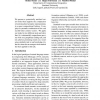Free Online Productivity Tools
i2Speak
i2Symbol
i2OCR
iTex2Img
iWeb2Print
iWeb2Shot
i2Type
iPdf2Split
iPdf2Merge
i2Bopomofo
i2Arabic
i2Style
i2Image
i2PDF
iLatex2Rtf
Sci2ools
85
Voted
ACL
2010
2010
Contextualizing Semantic Representations Using Syntactically Enriched Vector Models
We present a syntactically enriched vector model that supports the computation of contextualized semantic representations in a quasi compositional fashion. It employs a systematic combination of first- and second-order context vectors. We apply our model to two different tasks and show that (i) it substantially outperforms previous work on a paraphrase ranking task, and (ii) achieves promising results on a wordsense similarity task; to our knowledge, it is the first time that an unsupervised method has been applied to this task.
ACL 2010 | Computational Linguistics | Paraphrase Ranking Task | Quasi Compositional Fashion | Second-order Context Vectors |
| Added | 10 Feb 2011 |
| Updated | 10 Feb 2011 |
| Type | Journal |
| Year | 2010 |
| Where | ACL |
| Authors | Stefan Thater, Hagen Fürstenau, Manfred Pinkal |
Comments (0)

